Artificial Intelligence and IoT in Industrial Maintenance: Optimize, Predict, and Act with Real-Time Data
- Nexxant

- 18 de jun.
- 15 min de leitura
Introduction
The industrial maintenance sector is undergoing a quiet yet powerful transformation. The combination of Artificial Intelligence (AI) and the Internet of Things (IoT) is reshaping how companies plan, execute, and optimize their maintenance strategies. More than just a technological evolution, this represents a shift in mindset: moving away from purely reactive or time-based approaches and advancing towards predictive, proactive, and real-time data-driven maintenance management.
IoT sensors distributed across equipment, machinery, and critical infrastructure now monitor variables such as temperature, vibration, pressure, and humidity, transmitting a continuous stream of data to analytical systems. When processed by machine learning algorithms and AI models, this data transforms from passive information into predictive insights and actionable maintenance recommendations.
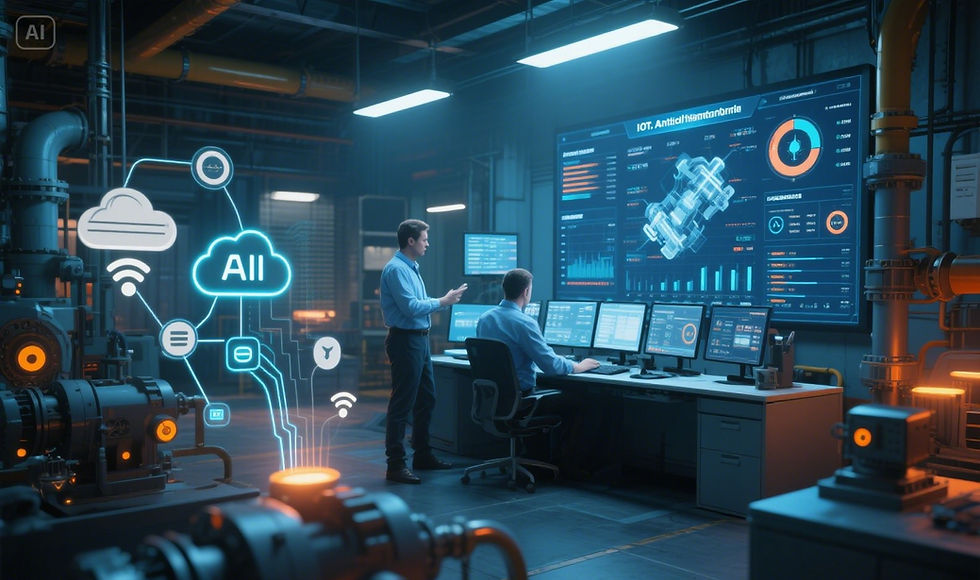
The rapid growth of this market highlights the ongoing transformation. According to Statista, the global Industrial Internet of Things (IIoT) market was valued at over 544 billion US dollars in 2022, with projections to reach approximately 3.3 trillion dollars by 2030. Meanwhile, predictive maintenance, one of the most impactful applications of IoT and AI, is also experiencing significant expansion. According to Market.US, the segment is expected to grow at a compound annual growth rate (CAGR) of 28.5% until 2033, driven by the adoption of Industry 4.0 technologies.
In this article, we’ll explore how IoT and Artificial Intelligence in maintenance are complementing each other to reduce costs, prevent unexpected failures, optimize resources, and create more resilient industrial operations. We’ll present real-world application examples, technical challenges, and strategies to integrate these technologies and reach the next level of efficiency, unlocking the full potential that the convergence of AI and IoT can offer.
1. What Is IoT and How Is It Revolutionizing Maintenance?
1.1 The Concept of Industrial Internet of Things (IIoT)
The Internet of Things (IoT), in its industrial branch known as the Industrial Internet of Things (IIoT), refers to the interconnection of physical devices, sensors, machines, and systems through the internet. The goal? To collect, transmit, and analyze operational data in real time.
Instead of relying solely on manual inspections or periodic measurements, IoT in maintenance enables a continuous flow of information, with sensors monitoring variables such as temperature, vibration, pressure, humidity, and even gas levels.
With this connectivity, industrial assets are no longer "black boxes". They become active data sources, continuously reporting on their own performance and health status.
1.2 Remote Monitoring and Real-Time Data Collection
Remote asset monitoring is one of the most immediate and valuable applications of IoT in maintenance. Sensors installed on industrial equipment constantly capture information about the operation of motors, pumps, turbines, boilers, hydraulic systems, and other critical assets.
This data is transmitted in real time to cloud-based platforms or local servers with high processing capacity. The result is a consolidated, instant view of the entire industrial plant—accessible from anywhere through dashboards, mobile apps, or asset management software.
This level of monitoring enables companies to:
Detect operational anomalies before they escalate into critical failures.
Reduce maintenance response times.
Build detailed performance histories for each piece of equipment.
Anticipate mechanical failures based on data trends.
1.3 Types of IoT Sensors Used in Maintenance
The success of IoT applied to industrial maintenance begins with selecting the right sensors. Each sensor type is responsible for monitoring a specific aspect of the assets:
Temperature Sensors: Detect abnormal temperature changes that may indicate overheating or imminent failure in motors and transformers.
Vibration Sensors: Essential for rotating equipment. They help identify misalignments, looseness, bearing wear, and other mechanical issues.
Humidity Sensors: Monitor relative humidity levels in sensitive environments like server rooms or control cabinets.
Pressure Sensors: Ensure the stability of hydraulic and pneumatic systems, detecting leaks or blockages.
Motion Sensors: Monitor unexpected machine movements or even unauthorized access to restricted areas.
Gas Sensors: Critical for industrial safety, alerting about the presence of toxic or flammable gases.
With ongoing technological advancements, new types of sensors are continually emerging, expanding the possibilities of IoT in predictive maintenance and industrial asset management.
2. Practical Applications of IoT in Asset Maintenance
The true power of the Internet of Things in maintenance lies not just in data collection but in the ability to turn this information into actionable decisions. Industrial IoT (IIoT) is already transforming the daily operations of maintenance teams across multiple sectors, from energy to manufacturing.
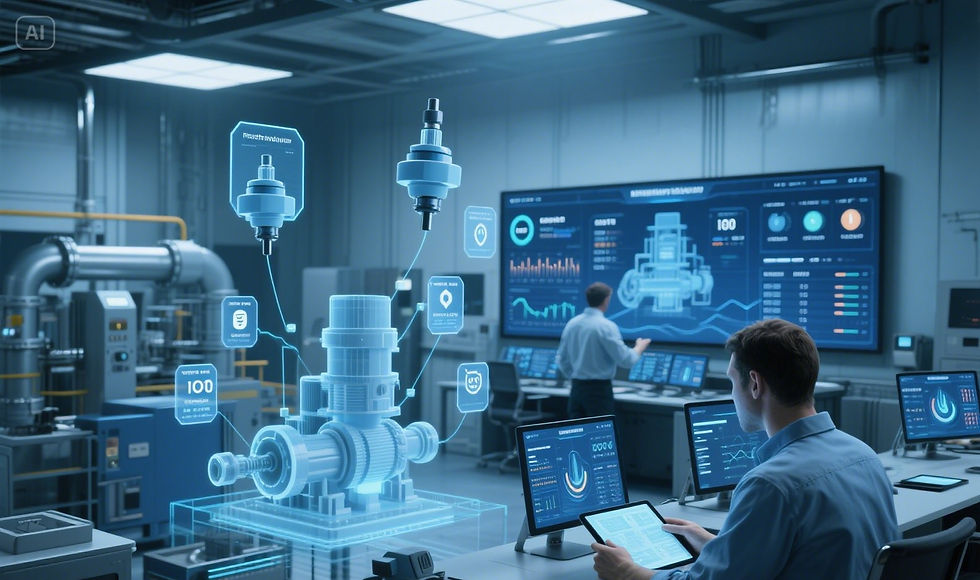
2.1 Predictive Maintenance with IoT: Anticipating Failures Before They Happen
One of the most revolutionary applications of IoT in maintenance is predictive maintenance. Instead of performing maintenance at fixed intervals (like traditional preventive maintenance) or only after failures occur (corrective maintenance), companies can now act before problems arise.
Connected sensors gather information such as vibration levels, abnormal temperature, pressure fluctuations, or electrical current variations. These data streams are processed in real time by analytical systems that identify behavioral patterns preceding failures.
This approach allows companies to:
Reduce unplanned downtime.
Prevent catastrophic equipment failures.
Extend the useful life of assets.
Minimize emergency maintenance costs.
2.2 Process Optimization with Automation and Data
IoT-driven maintenance goes beyond monitoring. It enables automation of routine tasks, such as:
Automatic generation of work orders when predefined thresholds are exceeded.
Real-time notifications to field technicians.
Automatic updates of maintenance KPIs.
Furthermore, by combining historical data with current operational conditions, maintenance teams can reschedule routines, adjust inspection intervals, and optimize resource allocation.
2.3 Smart Inventory Management for Spare Parts
Another major benefit of IoT in industrial maintenance is intelligent inventory management.
Through RFID sensors and smart tags, companies can track, in real time, the quantity and location of critical spare parts.
Key advantages include:
Avoiding excess inventory and unnecessary storage costs.
Reducing the risk of stockouts that could halt production.
Anticipating replenishment needs based on historical consumption trends.
2.4 Condition-Based Maintenance: Ending Fixed Intervals
With IoT, companies are shifting towards Condition-Based Maintenance (CBM).
Instead of following rigid maintenance schedules, interventions are carried out only when sensors indicate that equipment is deviating from normal operating conditions.
Common triggers include:
Excessive vibration.
Out-of-range temperature.
Pressure below operational minimum.
Detection of gases signaling internal failures.
This approach delivers higher operational efficiency, cost reduction, and a significant increase in asset availability. IoT in asset maintenance is already a reality in the most competitive industries worldwide.
2.5 Performance Analysis and Operational Trend Monitoring
One of the greatest advantages of IoT in asset maintenance is the ability to perform performance analysis and trend identification based on real operational data.
With IoT sensors continuously collecting variables like temperature, vibration, pressure, and operating cycles, managers can generate historical dashboards and analytical reports that reveal:
Wear patterns in critical equipment.
Failure rates over time.
Abnormal performance variations.
Comparisons between different plants or production units.
This long-term analysis enables the implementation of continuous improvement strategies and supports asset criticality classification.
Additionally, with Business Intelligence (BI) tools integrated into maintenance management systems (like CMMS and EAM), companies can generate predictive KPIs, such as:
MTTF (Mean Time to Failure)
MTBF (Mean Time Between Failures)
Preventable failure rate
This data-driven perspective strengthens both risk management and strategic maintenance planning.
2.6 Data-Driven Decision Making in Maintenance
Another direct application of IoT in asset maintenance is the transformation of decision-making processes, now guided by objective, real-time data.
Previously, many maintenance decisions were based purely on empirical experience, reactive maintenance plans, or fixed preventive maintenance schedules. With real-time data analysis, managers can now:
Prioritize work orders based on actual failure risk.
Dynamically adjust maintenance schedules.
Allocate human and material resources more efficiently.
Calculate the cost-benefit between immediate and deferred maintenance actions.
Modern IoT solutions integrated with Artificial Intelligence go beyond data collection: they deliver automated recommendations, smart alerts, and even automatically generated work orders based on predictive analytics.
Companies adopting this data-driven decision-making model are reporting significant operational cost reductions, along with improved asset reliability and increased uptime.
This new approach is one of the core pillars of Maintenance 4.0, where operational intelligence becomes a key competitive advantage.
3. Where Does Artificial Intelligence Fit in Maintenance?
If IoT in maintenance is responsible for collecting real-time data, Artificial Intelligence (AI) is what gives meaning to that data—turning information into actionable insights. The integration between AI and IoT in maintenance is creating a new paradigm: intelligent and autonomous maintenance.
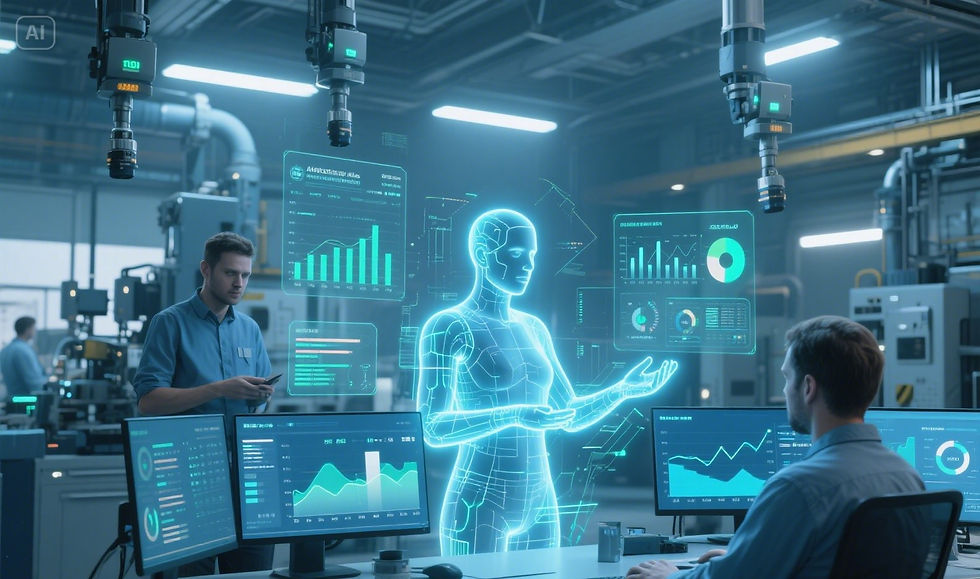
3.1 From IoT to AI: Turning Data into Decisions
With distributed sensors generating thousands of data points per second, the real challenge is analyzing this massive volume of information with speed and precision.
This is where machine learning, deep learning, and AI-driven maintenance algorithms come in. These models are trained to recognize hidden patterns in operational data, detect anomalies, and predict failure events in advance.
Common applications include:
Early detection of component degradation.
Identification of correlations between different process variables.
Estimation of Remaining Useful Life (RUL) for critical equipment.
By leveraging AI in maintenance, companies can transition from reactive responses to predictive and strategic decision-making.
3.2 Advanced Predictive Analytics: From Diagnosis to Prognosis
Artificial Intelligence in maintenance goes far beyond simple failure detection.
Today, companies are using predictive models that combine historical maintenance data, current operational conditions, and statistical modeling to forecast:
The exact timing of a potential failure.
The most probable failure mode.
The financial impact if the failure is not addressed promptly.
This risk-based asset management approach allows maintenance teams to prioritize corrective actions where the likelihood of critical downtime is highest.
3.3 Virtual Assistants and AI-Powered Recommendation Systems
Another practical application of AI in maintenance is the use of technical virtual assistants.
Through specialized chatbots or AI-based recommendation systems, technicians can easily access:
Recommended procedures for specific failure types.
Historical records of similar incidents.
Suggestions for the most critical spare parts.
Optimized task sequences for executing the maintenance.
This context-aware intelligence empowers teams to make faster and more accurate decisions, even under high operational pressure.
3.4 AI in Resource Optimization and Field Service Logistics
AI is also transforming how companies allocate their maintenance technicians.
Optimization algorithms, combined with real-time IoT data, can:
Define the most efficient routes for field technicians.
Prioritize service orders based on operational criticality.
Reduce the time between fault diagnosis and service execution.
This direct integration between IoT, predictive analytics, and field service management is helping companies lower logistics costs and improve internal service level agreements (SLAs).
With continuous advancements in machine learning technologies, the role of Artificial Intelligence in industrial maintenance is expected to become even more central in the coming years.
4. How to Integrate IoT and Artificial Intelligence to Create Autonomous Maintenance
The true revolution begins when IoT and Artificial Intelligence in maintenance stop operating in isolation and start working in a synchronized and interdependent manner. This integration is paving the way for what many industry experts are calling Autonomous Maintenance, where the system itself identifies, decides, and even executes certain maintenance actions.
4.1 Architecture of an Intelligent Maintenance System
To successfully integrate IoT and AI in maintenance, companies need to adopt a layered technological architecture, typically composed of:
IoT Sensor Layer: Responsible for capturing real-time physical variables like temperature, pressure, vibration, and equipment status.
Edge Computing Layer: Initial data processing close to the source, reducing latency and minimizing cloud traffic.
Cloud Layer: Massive storage and processing of historical data, in addition to running advanced machine learning and AI models.
Predictive AI Layer: Where anomaly detection, failure predictions, action suggestions, and even spare parts recommendations occur.
Action and Execution Layer: Automation of work orders, real-time alerts, and even automatic activation of emergency systems.
This structure enables the full maintenance cycle—Plan → Monitor → Analyze → Decide → Act—to occur with minimal human intervention.
4.2 Real-World IoT + AI Integration Cases
Industry leaders like Siemens, GE Digital, IBM Maximo, and Honeywell are already implementing large-scale predictive maintenance solutions using AI and IoT.
Some practical examples include:
Automatic wear detection in power turbines, based on vibration and temperature patterns.
Predictive maintenance for electric motors, where machine learning algorithms analyze current and torque data.
Railway system predictive analytics, where IoT sensors installed along tracks feed AI models that forecast failures in rails and train components.
The integration of AI with IoT in maintenance is no longer a lab experiment—it’s an active part of the industrial market, delivering efficiency gains and cost reductions across various sectors.
4.3 Benefits of IoT + AI Synergy in Maintenance
The union between Internet of Things and Artificial Intelligence in maintenance brings several tangible benefits:
Reduced Operational Costs: Fewer emergency repairs and better failure predictability.
Increased Asset Availability: Less downtime and higher equipment productivity.
Data-Driven Decision Making: Eliminating guesswork when prioritizing work orders.
Process Automation: From fault detection to the automatic generation of maintenance work orders within the management system.
This technological convergence is the backbone of Maintenance 4.0, where data becomes the key strategic asset to ensure operational reliability.
5. Challenges and Considerations in Implementing IoT and AI in Maintenance
Integrating IoT and Artificial Intelligence in industrial maintenance is a strategic step that promises significant efficiency gains. However, the path toward truly intelligent and autonomous operations involves a series of technical, organizational, and even cultural challenges.
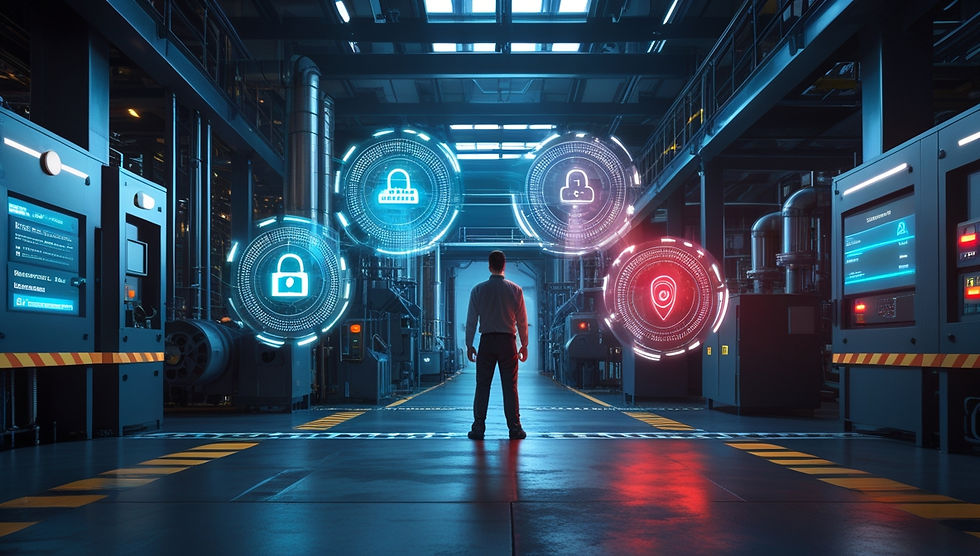
5.1 Data Quality and Reliability
The first barrier to the success of any predictive maintenance project using IoT and AI is data quality.
Without accurate, consistent, and reliable data, even the most advanced machine learning algorithms will generate inaccurate or misleading diagnostics.
Key risks include:
Poorly calibrated sensors or unstable readings
Communication failures between IoT devices and analysis platforms
Incomplete data or packet loss during transmission
Solution: Invest in rigorous data validation and cleansing processes, and implement redundancy where necessary.
5.2 Integration with Legacy Systems
Many industrial plants still rely on legacy maintenance systems (like older ERPs or CMMS platforms) that were not designed to handle massive IoT data streams.
The challenge here is to integrate the new and the old, ensuring that AI-generated insights reach field teams in a fluid and actionable way.
Middleware tools, open APIs, and industrial communication protocols like MQTT and OPC UA are some of the most widely used technical solutions to bridge this gap.
5.3 Cybersecurity: Protecting Industrial Data
With thousands of sensors connected in real time, the cybersecurity surface grows exponentially.
Major risks include:
Attacks through poorly secured IoT devices
Theft of sensitive industrial data
Ransomware attacks targeting maintenance infrastructure
Essential measures include:
Strong authentication on all devices
Specific network segmentation for IoT traffic
End-to-end encryption for data transmission
Cybersecurity must be a built-in layer in the project from the design phase onward.
5.4 Cultural Barriers and Internal Resistance
No matter how advanced the technology, the adoption of AI and IoT in maintenance only happens when the people operating the system trust it.
Often, maintenance teams may view the new technology as a threat to job security or see it as a complex, difficult-to-operate system.
Practical solutions:
Continuous training for maintenance teams
Focus on building a data-driven culture
Gradual implementation with well-planned proof-of-concept stages
Once professionals see that the technology enhances their decision-making capacity, resistance tends to diminish.
5.5 Initial Implementation Costs
Finally, one factor that cannot be ignored: the upfront investment.
Implementing IoT sensors, building a robust data infrastructure, and developing AI models for industrial maintenance come with a significant cost.
However, many companies that have already adopted this integration report substantial paybacks in less than two years, thanks to reduced catastrophic failures and optimized maintenance resources.
5.6 IoT Device Maintenance and Updates: An Ongoing Challenge
While IoT devices bring a range of benefits to industrial maintenance, they also require active device lifecycle management and ongoing updates.
Each sensor, transmitter, or controller distributed across industrial sites operates like a small networked computer. This means that beyond physical maintenance, these devices also require regular firmware and software updates to ensure:
Improved data collection performance
Security vulnerability patches
Communication protocol adjustments
Compatibility with new AI platforms or CMMS systems
For companies with large fleets of distributed IoT sensors, especially in remote locations, manual updates become unfeasible.
That’s why it’s essential to implement a centralized IoT device management system, with features like:
Over-the-Air (OTA) updates, enabling remote firmware upgrades
Device health dashboards showing operational status, need for intervention, or communication failures
Lifecycle policies defining scheduled review, calibration, and device replacement dates
Additionally, continuous health monitoring of IoT sensors is crucial to avoid blind spots in data analysis. A faulty sensor can produce inconsistent data, compromising the efficiency of AI algorithms for predictive maintenance.
In short: Maintaining IoT sensors becomes a new layer within the broader industrial maintenance strategy. Ignoring this aspect can jeopardize the entire predictive monitoring chain and the reliability of monitored assets.
6. Leading IoT and Artificial Intelligence Providers for Maintenance in the United States
The digital transformation in industrial maintenance is no longer a future vision—it’s a present reality. Across the U.S., a mature ecosystem of technology providers offers comprehensive solutions that combine Industrial IoT (IIoT), predictive analytics, machine learning, and cloud-based asset management.
Below are some of the most influential players currently driving the AI and IoT maintenance revolution in the American industrial market.
6.1 American Companies Specializing in AI and IoT for Maintenance
Uptake Technologies
Headquartered in Chicago, Uptake is one of the most prominent U.S.-based companies delivering AI-driven predictive maintenance solutions for sectors like energy, transportation, and heavy industry.Key differentiators include:
Specialized machine learning models for asset health monitoring
Real-time failure prediction based on historical and operational IoT data
Integration with existing CMMS and ERP systems
Proven use cases in railways, wind farms, and mining operations
SparkCognition
Located in Austin, Texas, SparkCognition is recognized for its expertise in applying AI and predictive analytics to industrial maintenance.Highlights include:
AI-based diagnostics for critical equipment
Natural language processing modules for work order analysis
Customized industrial AI models tailored for manufacturing, aerospace, and oil & gas
ThingLogix
A California-based company focused on providing IoT application frameworks that help organizations deploy scalable maintenance solutions.Main features:
Real-time IoT data processing
Automated workflows for asset condition monitoring
Flexible integration with third-party AI engines
6.2 Global Technology Giants with Strong U.S. Presence
Siemens – MindSphere
MindSphere offers an extensive Industrial IoT platform, widely used in manufacturing and energy sectors across the U.S., supporting predictive maintenance and real-time asset performance monitoring.
IBM Maximo Application Suite
A global leader in Enterprise Asset Management (EAM) and AI-driven maintenance analytics. IBM Maximo integrates seamlessly with IoT devices and leverages IBM’s Watson AI for predictive insights and failure forecasting.
GE Digital – Predix
GE’s Predix platform focuses on asset performance management (APM) and industrial IoT analytics, delivering condition-based maintenance tools for sectors like aviation, power generation, and manufacturing.
Honeywell Forge
Honeywell offers industrial IoT and AI analytics solutions tailored for critical asset monitoring in sectors like energy, manufacturing, and logistics.
Microsoft Azure IoT + AI Services
With its highly scalable cloud computing and machine learning infrastructure, Microsoft Azure remains a top choice for companies looking to build customized predictive maintenance solutions that integrate IoT data streams with AI-driven decision-making.
6.3 Highlight: Uptake Technologies – AI-Native Predictive Maintenance in the U.S.
Among all U.S.-based players, Uptake Technologies stands out as a key reference for companies looking to combine AI and IoT for predictive maintenance.
Key Differentiators of Uptake:
Purpose-built AI models for sectors like mining, transportation, and energy
Real-time predictive alerts based on industrial IoT data feeds
Rapid deployment frameworks for CMMS and ERP integration
Strong ROI case studies demonstrating downtime reduction and operational efficiency gains
Recognized by Gartner and Forrester as a leader in Industrial AI
With this positioning, Uptake Technologies not only dominates in the U.S. market but is also expanding its footprint globally as a leader in AI-driven maintenance solutions.
6.4 Quick Comparison Table
Provider | Headquarters | Core Strength |
Uptake Technologies | USA (Chicago) | AI-native predictive maintenance |
SparkCognition | USA (Austin) | AI for industrial diagnostics |
ThingLogix | USA (California) | IoT application frameworks |
Siemens MindSphere | Germany/USA | Scalable industrial IoT |
IBM Maximo | USA | EAM with AI and IoT integration |
GE Predix | USA | Industrial APM and IoT analytics |
Honeywell Forge | USA | Critical asset monitoring |
Microsoft Azure IoT | USA | Custom IoT + AI infrastructure |
Final Considerations: Choosing the right provider for AI and IoT maintenance solutions depends on factors like project scale, required customization, legacy system compatibility, and available technical support. For companies in the United States, Uptake Technologies emerges as a leading choice for fast deployment and proven ROI in the field of predictive maintenance with AI and IoT.
7. IoT Implementation Guide for Maintenance Management and Operational Routines
The adoption of the Internet of Things (IoT) in asset maintenance goes far beyond simply installing sensors. It represents a structural transformation in management processes, monitoring practices, and decision-making routines across industrial maintenance operations.
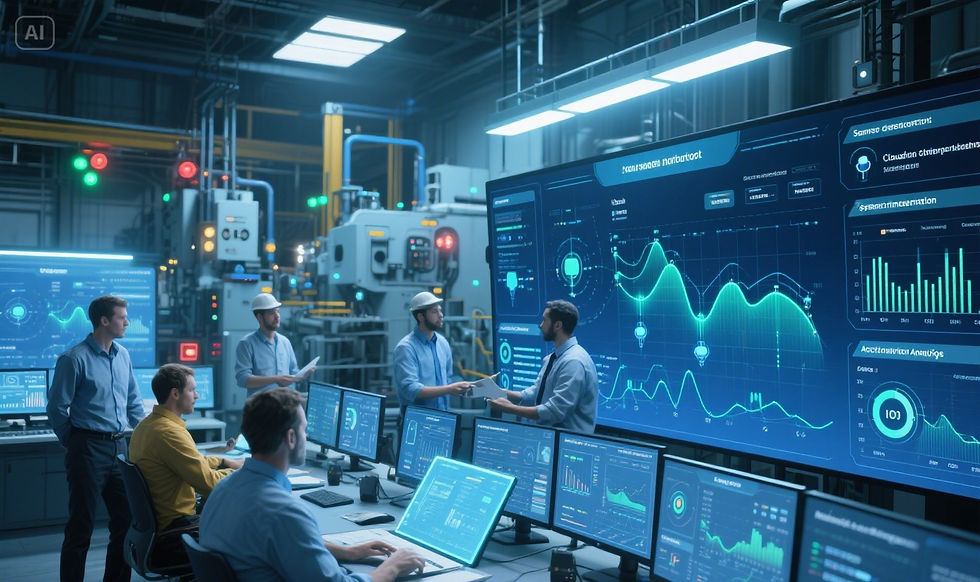
7.1 Assessing Operational Needs
The first step toward a successful IoT implementation in industrial maintenance is conducting a comprehensive assessment of the company’s needs. This includes mapping:
Major causes of recurring equipment failures
Impact of unplanned downtime on production
Excessive spending on corrective maintenance
Current levels of operational efficiency and response time
This diagnostic phase helps identify critical areas that will benefit the most from remote monitoring and predictive analytics technologies.
7.2 Defining Strategic Objectives
Based on the needs assessment, the next step is to set clear and measurable goals for the IoT deployment. Examples of objectives include:
Reducing unplanned downtime
Improving asset availability rates (OEE)
Optimizing energy consumption
Extending equipment lifecycle
This step ensures alignment between engineering, IT, and asset management teams.
7.3 Selecting the Right IoT Sensors and Devices
Choosing the appropriate IoT sensors for maintenance depends on the critical parameters of each asset. The most commonly used include:
Temperature sensors
Vibration sensors
Humidity sensors
Pressure sensors
Motion and presence sensors
Gas detection sensors
Other key selection criteria include sensor accuracy, measurement range, durability in harsh environments, and wireless communication capabilities.
7.4 Implementing the IoT Infrastructure
This phase involves installing the necessary infrastructure for data transmission and processing, including:
Communication gateways
Industrial networks (LoRaWAN, NB-IoT, Industrial WiFi)
Cloud-based IoT platforms for data collection and storage
Cybersecurity measures should also be considered from the outset, ensuring that connected devices are protected against external threats.
7.5 Integrating IoT Data with Existing Management Systems
For IoT benefits to translate into actionable results, it’s essential to integrate the collected data with the maintenance team’s existing systems, such as:
CMMS (Computerized Maintenance Management Systems)
EAM (Enterprise Asset Management)
ERP (Enterprise Resource Planning)
This integration ensures that real-time insights are accessible during maintenance planning, resource allocation, and work order generation.
7.6 Data Analysis and Predictive Decision-Making
With the infrastructure in place, the focus shifts to intelligent data analysis. Analytics software and Artificial Intelligence platforms can be used to:
Detect wear patterns
Predict imminent failures
Optimize maintenance schedules
Generate automated alerts and action recommendations
This data-driven approach allows companies to transition from traditional corrective or preventive maintenance to predictive maintenance strategies, based on real-time and historical data.
Conclusion
The integration of Artificial Intelligence (AI) and the Internet of Things (IoT) is redefining asset management and industrial maintenance standards. What was once a reactive process, driven by unexpected failures and corrective maintenance, is now shifting toward an era of predictive maintenance, data-driven decision-making, and real-time operations.
By combining IoT devices, smart sensors, and AI platforms, companies can:
Remotely monitor critical assets
Accurately predict failures
Optimize resource allocation
Reduce operational costs
Improve safety and operational sustainability
However, the digital transformation journey in maintenance is not without challenges. Cybersecurity risks, big data management, system integration, and even IoT device maintenance require careful planning and a structured approach.
Solutions offered by industry leaders like Uptake Technologies, IBM Maximo, GE Digital, and others prove that scalable and ROI-focused deployment of AI and IoT for maintenance is achievable.
For organizations aiming to stand out in the era of Maintenance 4.0, the message is clear: the future of maintenance will be connected, intelligent, and increasingly driven by real-time data insights.
Ready to take the next step? Evaluate your current operation stage, define your objectives, and start building your predictive maintenance journey with IoT and Artificial Intelligence.
Did you like this article? Share it with your team and help your company take the next step toward Smart Maintenance!
Enjoyed this article? Share it on social media and continue to follow us to stay tuned on the latest in AI, breakthroughs and emerging technologies.
Thanks for your time!😉
